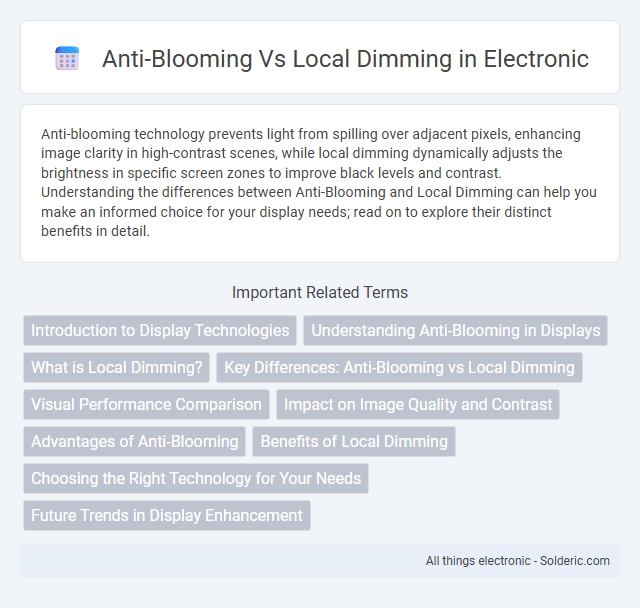Anti-blooming technology prevents light from spilling over adjacent pixels, enhancing image clarity in high-contrast scenes, while local dimming dynamically adjusts the brightness in specific screen zones to improve black levels and contrast. Understanding the differences between Anti-Blooming and Local Dimming can help you make an informed choice for your display needs; read on to explore their distinct benefits in detail.
Comparison Table
| Feature | Anti-Blooming | Local Dimming |
|---|---|---|
| Purpose | Prevents light bleed in image sensors | Enhances contrast in LCD displays |
| Technology | Sensor pixel-level charge control | Backlight zone control |
| Use Case | Camera sensors to reduce halo effect | TVs and monitors for deep blacks |
| Effect | Reduces blooming and ghosting in photos | Improves contrast ratio and black levels |
| Implementation | Integrated in CMOS/CCD sensors | LED zones dimmed individually |
| Visible Impact | Sharper image capture without light bleed | Richer visuals with better contrast |
Introduction to Display Technologies
Anti-blooming and local dimming are advanced display technologies designed to enhance image quality by managing light and contrast effectively. Anti-blooming prevents bright light sources from spilling over into adjacent pixels, ensuring clearer and sharper visuals, while local dimming dynamically adjusts the brightness of specific screen zones to improve contrast and deep blacks. Your choice between these technologies depends on whether you prioritize clarity in bright scenes or overall contrast enhancement in your display.
Understanding Anti-Blooming in Displays
Anti-Blooming technology in displays minimizes unwanted light bleeding around bright objects on dark backgrounds by controlling the electric charge in image sensors. Unlike Local Dimming, which adjusts the backlight zones to improve contrast, Anti-Blooming targets pixel-level charge overflow to maintain image clarity and prevent halos. Understanding how Anti-Blooming works helps Your display deliver sharper visuals, particularly in high-contrast scenes.
What is Local Dimming?
Local dimming is a backlighting technology used in LED LCD displays that enhances contrast by independently controlling the brightness of specific screen zones. This technique dramatically improves black levels and reduces halo effects, resulting in deeper blacks and more vivid colors. Unlike anti-blooming, which addresses light leakage within individual pixels, local dimming optimizes the display's overall dynamic range for a superior viewing experience.
Key Differences: Anti-Blooming vs Local Dimming
Anti-blooming technology in camera sensors prevents light from bleeding into adjacent pixels, enhancing image clarity and reducing glare in high-contrast scenes. Local dimming, used in LED displays, improves contrast by selectively dimming backlight zones, resulting in deeper blacks and better overall picture quality. The key difference lies in their applications: anti-blooming is designed for sensor-level light management in photography, while local dimming optimizes brightness and contrast in display panels.
Visual Performance Comparison
Anti-blooming technology minimizes light spillover around bright objects on digital sensors, enhancing image clarity by reducing halo effects and preserving sharp contrast. Local dimming improves visual performance on displays by selectively dimming dark areas of the screen, increasing contrast ratio and deepening blacks without affecting bright zones. Your viewing experience benefits most when anti-blooming handles sensor-level clarity and local dimming enhances screen-level contrast, delivering sharper images and richer visuals.
Impact on Image Quality and Contrast
Anti-blooming technology reduces halo effects around bright objects by controlling sensor overflow, enhancing image clarity without compromising contrast. Local dimming improves contrast by dynamically adjusting the backlight in specific screen zones, resulting in deeper blacks and more vivid colors. Your viewing experience benefits most when these technologies optimize image quality and contrast based on display type and environment.
Advantages of Anti-Blooming
Anti-blooming technology significantly reduces halo effects around bright objects on screens, enhancing image clarity and sharpness. Your viewing experience benefits from improved contrast and better color accuracy in high-contrast scenes, especially in LCD displays. Unlike local dimming, anti-blooming prevents light leakage without the need for complex zone control, resulting in smoother and more consistent picture quality.
Benefits of Local Dimming
Local dimming enhances contrast ratio by independently controlling the brightness of LED zones, resulting in deeper blacks and more vibrant colors compared to anti-blooming technology. This feature significantly reduces halo effects around bright objects on dark backgrounds, improving overall picture quality and immersion. Enhanced HDR performance is another benefit, as local dimming helps to accurately represent both bright highlights and dark details within the same scene.
Choosing the Right Technology for Your Needs
Anti-blooming technology in image sensors prevents light overflow between pixels, ensuring sharper visuals crucial for photography and scientific imaging, while local dimming enhances LED screen contrast by adjusting backlight zones to improve dark scene detail and reduce halo effects. For applications requiring precise image clarity, such as cameras and microscopes, anti-blooming circuits are essential, whereas local dimming excels in TVs and monitors by delivering deeper blacks and energy efficiency. Selecting the right technology depends on whether your priority is pixel-level light management or overall display contrast enhancement.
Future Trends in Display Enhancement
Anti-blooming and local dimming technologies are evolving to improve contrast and image clarity in modern displays, with local dimming delivering deeper blacks through dynamic backlight control. Future trends indicate a shift toward more granular zones and AI-driven algorithms optimizing local dimming for personalized visuals, while anti-blooming techniques will advance to reduce halo effects around bright objects in high dynamic range content. Your viewing experience will benefit from these innovations as next-generation displays integrate both technologies for superior brightness control and enhanced picture quality.
Anti-Blooming vs Local Dimming Infographic

 solderic.com
solderic.com